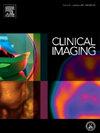18F-FDG-PET/CT对局部晚期印戒细胞食管腺癌分期有用吗?
IF 1.5
4区 医学
Q3 RADIOLOGY, NUCLEAR MEDICINE & MEDICAL IMAGING
引用次数: 0
摘要
目的胰网环细胞食管癌(SRCEC)是一种腺癌亚型,其中10% - 50%的细胞内含有黏液蛋白。关于SRCEC分期的PET/CT信息有限。本研究的目的是评估PET/CT在局部晚期SRCEC患者分期中的作用。方法选取经活检证实的SRCEC患者91例,并进行FDG-PET/CT预处理。评估原发肿瘤的SUVmax,以及区域淋巴结的大小和SUVmax。在新辅助治疗后行术前FDG-PET/CT的患者中,评估原发肿瘤和淋巴结转移的反应。结果原发性肿瘤80/91例(88%)(SUVmax范围3.8 ~ 28)。11例未摄取FDG的肿瘤分期为T1N0-1 (n = 3)、t3n0 (n = 1)和T3N0-2 (n = 7),其中68例(75%)未摄取FDG。在32/68例非fdg贪婪淋巴结患者中,有12例(38%)活检呈阳性。23例有FDG结节,14例活检,3例转移阳性。放化疗后,73例(86%)在原发肿瘤中有持续的FDG摄取(SUVmax范围为3.5-17.9),68例(93%)有残留的恶性肿瘤。在原发肿瘤中FDG摄取消退的患者中,有8/11为持续性恶性肿瘤。关于淋巴结转移,41/84(49%)的手术标本中存在残留的淋巴结疾病,只有4(10%)的淋巴结存在FDG。结论pet /CT对SRCEC患者早期分期及新辅助治疗后的原发肿瘤诊断有一定的价值。PE/CT在放化疗前后检测局部区域淋巴结疾病的应用是有限的。本文章由计算机程序翻译,如有差异,请以英文原文为准。
Is 18F-FDG-PET/CT useful in staging of locally advanced signet-ring cell esophageal adenocarcinoma?
Objective
Signet-ring cell esophageal carcinoma (SRCEC) is a subtype of adenocarcinoma in which >10 %–50 % of cells have intracellular mucin. There is limited information regarding PET/CT in staging SRCEC. The purpose of this study is to evaluate the usefulness of PET/CT in staging patients with locally advanced SRCEC.
Methods
91 patients with biopsy-proven SRCEC and pretreatment FDG-PET/CT were included. SUVmax of the primary tumor, and size and SUVmax of regional lymph nodes were evaluated. In patients who had presurgical FDG-PET/CT after neoadjuvant therapy, response of the primary tumor and nodal metastases were assessed.
Results
Primary tumor was avid in 80/91 (88 %) (SUVmax range 3.8–28). Stage of 11 tumors without FDG uptake was T1N0–1 (n = 3), T2N0 (n = 1) and T3N0–2 (n = 7). 68 (75 %) patients had non-FDG avid nodes. Biopsy in 32/68 patients with non-FDG avid nodes was positive in 12 (38 %). 23 had FDG avid nodes, 14 were biopsied and 3 were positive for metastases.
After chemoradiation, 73 (86 %) had persistent FDG uptake in the primary tumor (SUVmax range 3.5–17.9) and 68 (93 %) had residual viable malignancy. 8/11 patients with resolution of FDG uptake in the primary tumor had persistent malignancy.
Regarding nodal metastases, 41/84 (49 %) had residual nodal disease in surgical specimens and only 4 (10 %) had nodes that were FDG avid.
Conclusion
PET/CT is useful in detecting the primary tumor in patients with SRCEC during the initial staging and after neoadjuvant therapy. The utility of PE/CT in detecting locoregional nodal disease prior to and after chemoradiation is limited.
求助全文
通过发布文献求助,成功后即可免费获取论文全文。
去求助
来源期刊

Clinical Imaging
医学-核医学
CiteScore
4.60
自引率
0.00%
发文量
265
审稿时长
35 days
期刊介绍:
The mission of Clinical Imaging is to publish, in a timely manner, the very best radiology research from the United States and around the world with special attention to the impact of medical imaging on patient care. The journal''s publications cover all imaging modalities, radiology issues related to patients, policy and practice improvements, and clinically-oriented imaging physics and informatics. The journal is a valuable resource for practicing radiologists, radiologists-in-training and other clinicians with an interest in imaging. Papers are carefully peer-reviewed and selected by our experienced subject editors who are leading experts spanning the range of imaging sub-specialties, which include:
-Body Imaging-
Breast Imaging-
Cardiothoracic Imaging-
Imaging Physics and Informatics-
Molecular Imaging and Nuclear Medicine-
Musculoskeletal and Emergency Imaging-
Neuroradiology-
Practice, Policy & Education-
Pediatric Imaging-
Vascular and Interventional Radiology
 求助内容:
求助内容: 应助结果提醒方式:
应助结果提醒方式:


